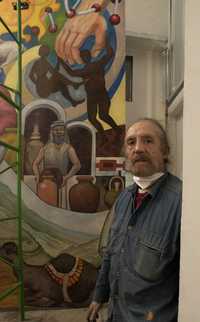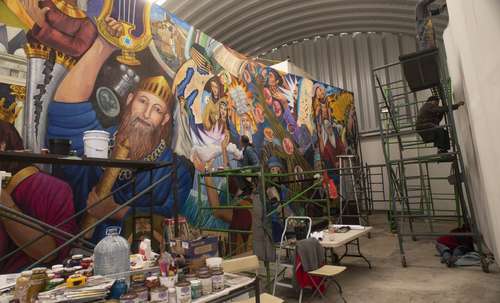A Mexican mural will receive passengers from the most important airport in Israel
A 220-square-meter mural, the work of Mexican artist Julio Carrasco Bretón, will be unveiled on June 22 at Ben Gurion International Airport, the largest and most important in Israel, located in Tel Aviv, as part of the 75th anniversary celebrations. of the State of Israel, in a ceremony expected to be attended by the president of that country, Isaac Herzog.
This is how he made it known as a scoop to The Conference the painter and poet himself (Mexico City, 1950), who finalizes the details of that work in a warehouse in the Mexican capital with a view to sending it to that nation in a few days, for placement.
Five meters high by 44 meters wide, the mural is named Am Yisrael chai (Israel is present). In it, the 4 thousand years of that town are condensed in a linear way, from an epic and historical perspective.
An epic is narrated, but also the initial thought, the entire epic of the millenary diaspora, those exoduses that the Israeli people have had and the cascade of repressions they have suffered from the time of the Egyptian pharaohs and the Roman empire until reaching the Holocaust. . It encompasses a wide range of elements and rituals of that culture, as well as the way in which they have preserved them to configure their identity with them.
explains Julio Carrasco.
It is a linear story in chronological terms, which implied a challenge, since from the perspective of composition theory it must have visual breaks, as well as fluidity, rhythm, movement; that is not something rigid, stiff. Neither pamphleteering nor tendentious. As a muralist, one must be a good historian: tell the story as it was, without omitting. It is, then, a narrative of that epic until the State of Israel manages to form.
It details that 57 characters of the Jewish people from all fields and sectors appear in the work, including Ben Gurion himself, Anne Frank, Albert Einstein and Shimon Peres, as well as a nod to Mexico, by capturing the flag on part of the mural of our country.
This piece was commissioned by businessman Isaac Assa Farca, from the Jewish community in Mexico, as a gift to the people of Israel, says the painter, who considers very flattering and meaningful
that they have chosen him for that task, since he was not born in Israel, nor is he a Jew; even, he assumes himself an agnostic, although he clarifies that he is very respectful
of all currents of thought with a mystical direction.
 ▲ The artist.Photo Gina Arechiga
▲ The artist.Photo Gina Arechiga
It was a great challenge, not only because of the place where it will be placed, but because there is no mural of this nature in Israel that speaks of Judaism in a complete way. It was not easy to weave a 4,000-year-old story that was fluid and translate it with figurative elements into an iconographic language.
he maintains in an interview.
One of the aspects that the artist considered crucial for the commission of this work was the technique he used, which is his invention: Carrasco’s isoplastic, named after his father, Julio Carrasco Rojo. This consists, more or less, in a sheet made of fiberglass and pulverized marble that does not crack and can be rolled up for easy transportation.
After assuring that he had full freedom in his work, without any prohibition or censorship, the painter highlights this as a totally Mexican mural, not only because for its realization he had the assistance of national painters Natalia Martínez, the brothers Juan Manuel and Javier Martínez Caltenco, José Luis Rueda, Ana María Vera and Joel Islas, as well as Daniela Assa, as an assistant. Also for the inputs and materials used.
It is painted with colors from Mexico, with mineral pigments mixed with acrylic, and covered with a sealant from a Mexican company, the one started by José L. Gutiérrez when he set up a laboratory at the National Polytechnic Institute, where Siqueiros did tests. Finally, I applied a layer of polyester resin that protects it from the sun’s rays by 98 percent, a varnish used on boats and planes.
For Julio Carrasco, the great satisfaction of making this mural –number 72 to his credit, several of which are in Europe, Africa and Latin America– it is that a Mexican artist contributes to the identity of other peoples, in this case the Israeli one, because I paint for the peoples, not for the governments. Governments perish, peoples persist
.
